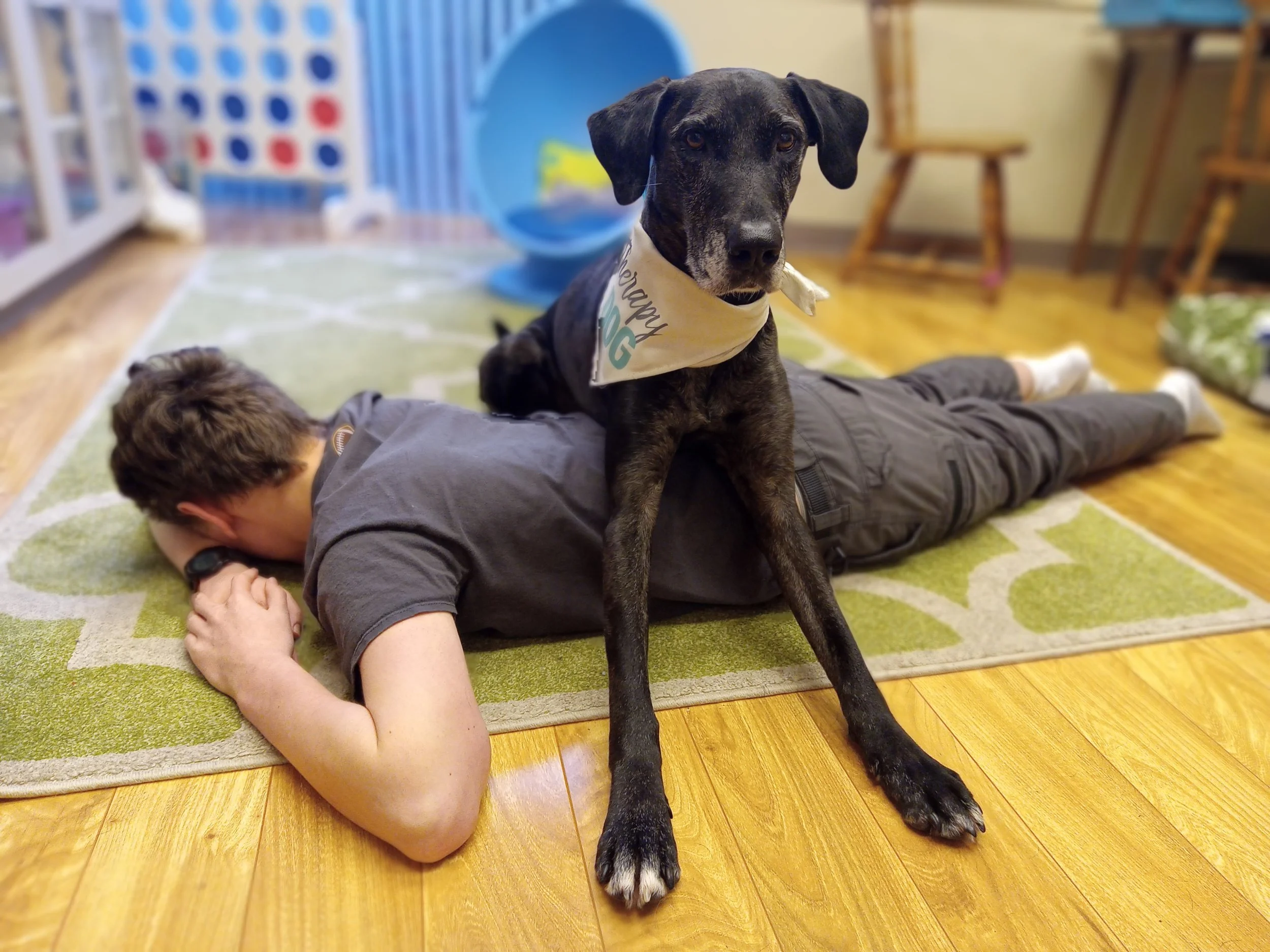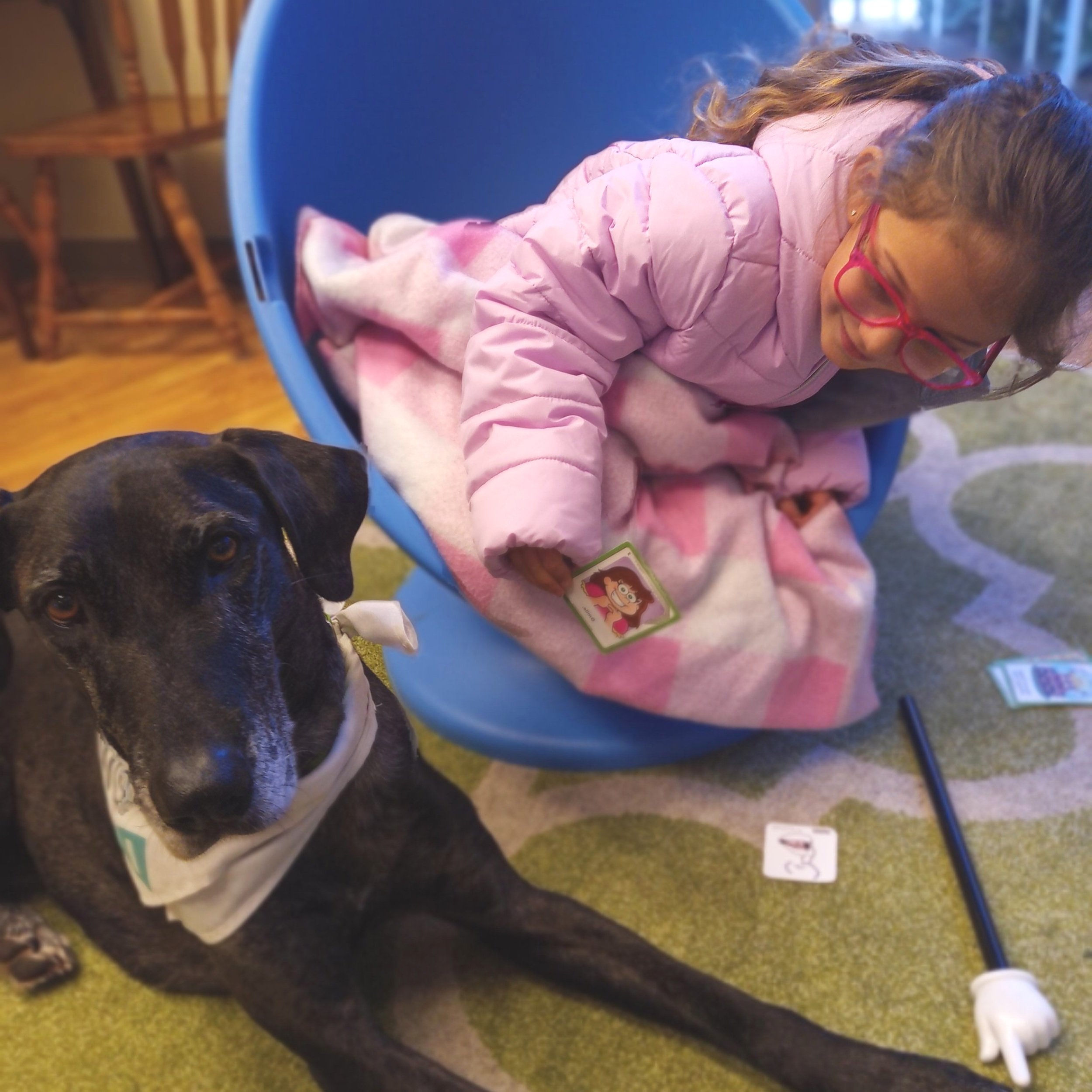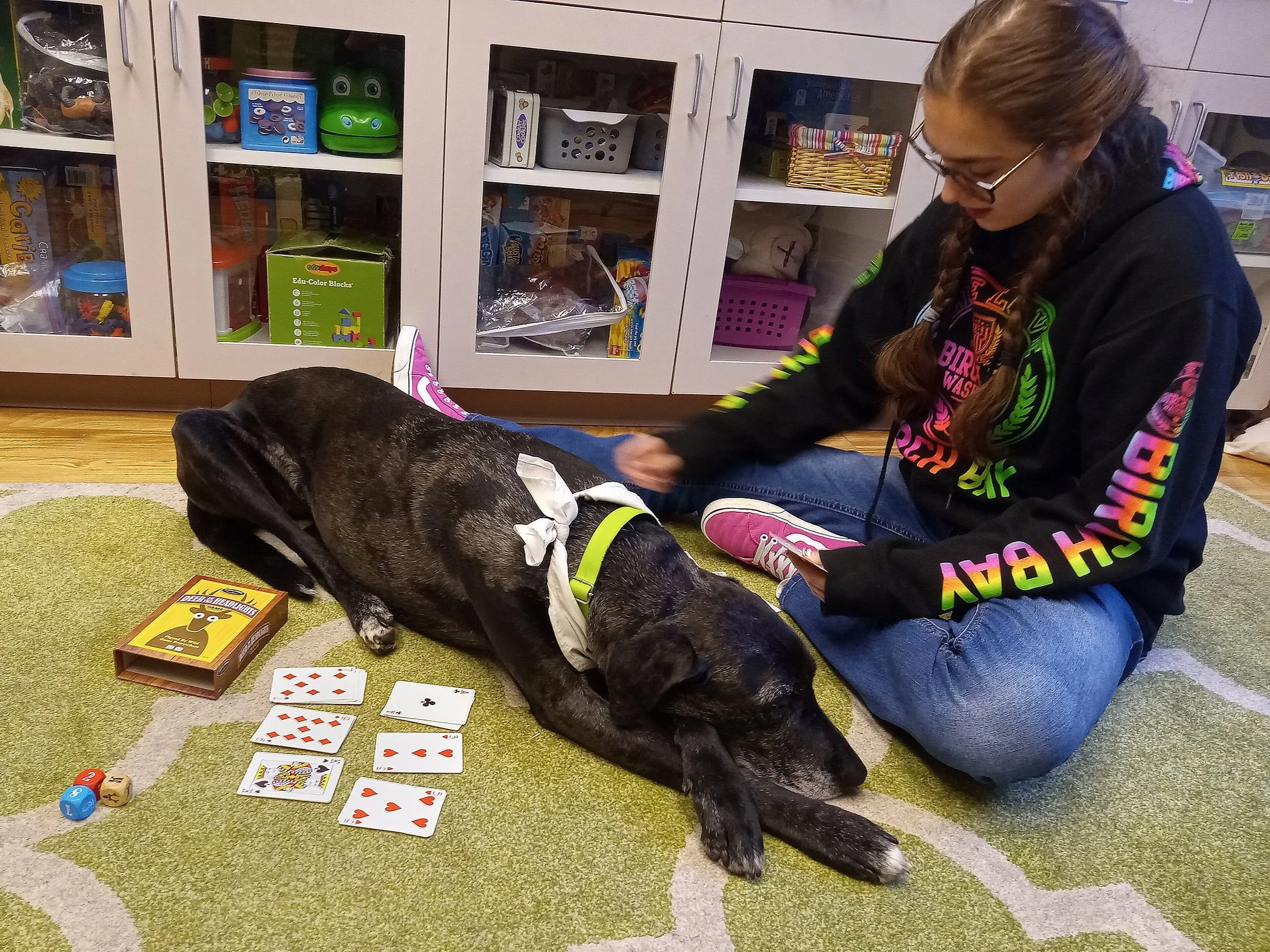
Frequently Asked Questions about Animal-Assisted Speech Therapy
If you don’t see your question below, please let me help by clicking the contact button below. Chances are someone else is looking for the same answer!
Are animal-assisted interventions (AAI) within the scope of practice for a speech-language pathologist?
Animal-assisted interventions are an adjunct to the treatment modalities and approaches already utilized by SLPs. They are not a stand-alone treatment approach, but are incorporated in various ways to aid in sensory regulation, enhance motivation, and/or provide opportunities for meaningful application of targeted communication skills where appropriate to maximize a client’s ability to benefit from therapy sessions. Therapy animal inclusion may also benefit in the establishment of rapport with clients and their caregivers.
The American Speech-Language Hearing Association (ASHA) recognizes that “speech-language pathology continually evolves” as well as that it “is a dynamic profession, and the overlapping scopes of practice is a reality in rapidly changing health care, education, and other environments” (Scope of Practice in Speech-Language Pathology, 2016). It does not specify treatment approaches, though it does emphasize the need to “utilize treatment data to guide decisions and determine effectiveness of services” as well as to “integrate the highest quality available research evidence with practitioner expertise and individual values and preferences” (emphasis mine). Thus, animal-assisted interventions should be assessed on a case-by-case basis for clients and adapted as needed to be maximally effective in improving client outcomes. AAI is goal-directed, not "just playing with dogs.”
ASHA’s Scope of Practice, in agreement with ASHA’s Code of Ethics, states that SLPs should “only practice in areas in which they are competent, based on their education, training, and experience.” Given the potential risks involved with implementing AAI, SLPs who partner with an animal should seek out on-going education specific to handling therapy animals of their chosen species. Skills to learn include understanding a therapy animal’s communication signals, recognizing their welfare needs, and managing behaviors that may be natural but incompatible with work, as well as understanding the potential impact of the human-animal bond .
Check out the Animal-Assisted Speech Therapy Resources page for helpful products and organizations or take a sneak peek at the upcoming Talk to the Paw! Foundations for Therapy Animal Inclusion in a Professional Setting course.
Is there any research supporting animal-assisted speech therapy?
Yes, though there is still a lot of research waiting to be done!
Sherrill & Hengst (2022) published Exploring Animal-Assisted Therapy for Creating Rich Communicative Environments and Targeting Communication Goals in Subacute Rehabilitation in the American Journal of Speech-Language Pathology. They found increased spontaneous communication (including talk time, mean length of turns, and use of interactional discourse resources such as narrative use and playful language) by a group of 10 adults with acquired neurogenic communication disorders. This study’s findings also suggest attendance may be higher for some clients when animal-assisted therapy is incorporated. To read the article, click here.
Research in the field of education, mental health, and occupational therapy also support the benefit of the human-animal bond and animal-assisted therapy with a variety of clients. For an excellent overview of the existing research compiled by the Association of Animal-Assisted Intervention Professionals and Pet Partners, please click here.
Anecdotal evidence for animal-assisted therapy in speech-language pathology showing improved outcomes in pediatric clients are documented in the book Paws for Progress: Integrating Animal-Assisted Interventions into Your Speech-Language Pathology Practice (ASHA Press, 2024). Benefits discussed include improved sensory regulation, improved memorability for concepts and activities, enhanced motivation to participate, and increased practice repetitions within sessions, in addition to improved clinician well-being.
There are many challenges that need to be overcome for high-quality, impactful research on animal-assisted speech therapy. To learn more, check out the article Quantifying the Power of Speech Therapy Dogs: Three Challenges to Research in Animal-Assisted Intervention
What is the difference between Animal-Assisted Therapy, Animal-Assisted Interventions, Animal-Assisted Education, and Animal-Assisted Activities?
Animal-Assisted Interventions (AAI) is an umbrella term that refers to any therapeutic approach that incorporates animals in some form to target a specific aspect of human well-being. Some organizations have recently changed to “Animal-Assisted Services (AAS)” as the catch-all term, making terminology a confusing aspect of this niche!
Animal-Assisted Therapy (AAT) is the intentional inclusion of an animal within a heath or human service professional’s practice to address a client’s goals.
If these goals are part of a general education curriculum or included within special education to meet an Individualized Education Plan, it may be termed Animal-Assisted Education (AAE).
The incorporation of a therapy dog may be to help improve motivation, increase memorability, or facilitate a more regulated emotional or sensory state to improve learning. Interactions with a therapy dog may also provide opportunities to practice an emerging skill or generalize a learned skill to new contexts. In both AAT and AAE, data is taken to monitor client progress and inform decision-making.
Examples include asking a dog to perform a trick that includes a targeted speech sound instead of practicing speech flash cards, practicing decoding by reading a passage to a dog, or asking the dog questions using a particular grammatical form while playing a game.
Click to see video examples of AAT with a therapy dog in speech, language, and reading intervention.
This is also sometimes referred to as “canine-assisted therapy”, “dog-assisted therapy”, or just “pet therapy”. However, many different species can be successfully incorporated into animal-assisted interventions. For more, click here for the Association of Animal-Assisted Intervention Professionals, “What is AAI?”
Animal-Assisted Activities (AAA) are the informal inclusion of a trained therapy animal to promote general well-being, such as decreasing anxiety or encouraging social interactions in general. These are typically performed by a volunteer therapy animal-handler team and are not directed to specific client goals or necessarily overseen by a rehabilitation professional.
In practical use, these terms often get used interchangeably, but the primary idea behind all of them is that the power of the Human-Animal Bond (HAB) can stimulate changes in physical, behavioral, and mental well-being.
What is Animal-Related Engagement?
Animal-Related Engagement (ARE) is using animal-themed books, videos, games, discussion topics, craft projects, or virtual visits with a therapy animal to target client goals. Biophilia is the theory that human brains are wired to want to interact with nature, including animals, and that regular interaction with the natural world fosters physical and mental well-being. Many children’s games and books, for example, incorporate animal characters because they are naturally engaging. ARE can be used in place of or in conjunction with a live therapy dog. To learn more, check out No Therapy Dog? No Problem. Animal-Related Engagement in Pediatric Speech and Language Therapy. Like other animal-assisted interventions, ARE is goal-directed and data-driven to improve a client’s outcomes.
Click here for examples of Animal-Related Engagement materials to use with child speech therapy clients.
How do I know if my dog has potential as a speech therapy dog?
Whether you’re hoping to partner with your dog professionally as a co-therapist at a speech therapy facility or as a volunteer therapy dog-handler team that visits medical or school facilities, the primary factor is a therapy dog’s affiliative behavior. Affiliative behavior is a drive to interact with humans and is part of the dog’s inherent temperament. Though training, socialization, and experience will further improve your dog’s ability to interact therapeutically, a speech therapy dog must first and foremost want to work with people.
Any breed can potentially have the affiliative nature needed for animal-assisted interventions to be mutually beneficial to both client and therapy dog. Some breeds are more commonly represented because they have been bred over generations to work well with humans, but individuals from many breeds and mixes are successfully engaged in animal-assisted therapy around the world.
Because dogs mature at different rates based on breed and individual factors, some dogs are better suited to start therapy dog work at an older age than others. A qualified dog trainer who is familiar with therapy dog work and/or a therapy dog certifying organization can help you navigate when and how to start introducing therapy work and guide you in prioritizing helpful manners and behaviors to train.
Basic manners are a must to keep speech therapy clients and their families safe and comfortable. Special tricks can be useful to address specific client goals, but are not necessary. Often just the speech therapy dog’s presence is enough to encourage more spontaneous utterances, help a client regulate their sensory system to improve learning readiness, and act as a neutral third party to reduce power struggles with clients who exhibit oppositional behaviors. Therapy dogs can also be used to help clients with challenging behaviors transition into and out of therapy.
For myths about animal-assisted therapy and why your dog might be better suited than you realize, check out the Puppy Wiggles and Children’s Giggles blog post “Five Myths about Speech Therapy Dogs.”
Is it possible to get liability insurance for a speech therapy dog?
If you are working for an employer—whether that’s a school district, hospital, or private clinic—check to see if they have any guidelines currently in place. If not, Association of Animal-Assisted Intervention Professionals offers a course on developing an animal-assisted intervention program manual to cover common workplace concerns such as infectious disease prevention, informed consent, incident reporting, and liability
If you are self-employed, check with your professional liability insurance provider. It may take some perseverance to get a firm answer as animal-assisted speech therapy is still fairly uncommon. You will want to know if there are any exclusions for working animals, any evaluations or registrations the therapy dog must obtain, and if damages such as mental anguish or property destruction by the therapy dog would be covered.
Likely you and your therapy dog will need to pass some form of third party evaluation, whether that’s earning a Canine Good Citizen award or passing a test by a therapy dog registering organization. (see Animal-Assisted Speech Therapy Resources for more information).
The Association of Animal-Assisted Intervention Professionals (AAAIP) started a pilot program in Fall ‘24 to provide assessment of professional therapy dog-handler teams, with those that pass eligible for a special liability policy (for more, click here). Read Peace of Mind for Therapy Dog Handlers: How I’m Working to Reduce My Risk as an Animal-Assisted Speech Therapist to learn more about this process and watch for updates on the availability of testing for new teams.
Although therapy animal organizations will provide liability coverage for you and your therapy dog in volunteer situations, this does not carry over to professional partnership with your dog. Homeowner’s insurance is also unlikely to cover animals being included for business purposes.
Therapy dog Delta provides deep pressure “squishes” to help regulate a child’s sensory system as a transition routine before starting structured speech therapy activities.
Delta listens to extra practice repetitions from a young speech therapy client as part of animal-assisted speech therapy.
Delta provides a calming presence during an articulation game with animal-assisted speech-therapy.
In what settings can a therapist partner with a speech therapy dog?
While private practice offices likely offer the most flexibility for incorporating animal-assisted speech therapy, some therapy dogs do work in hospital and school settings as well.
Some hospitals and outpatient clinics own facility dogs, who are raised and trained specially for full-time work with a designated hospital staff member. For more information about facility dogs, check out Canine Companions. Other hospitals incorporate the diamond model approach, in which a volunteer therapy dog-handler teams visits to help a therapist address specific goals with a patient. Pet Partners and Alliance of Therapy Dogs are two nationwide organizations who can help you coordinate with a volunteer team in your area, though there are many others.
Several pioneering school-based speech-language pathologists work with their own therapy dogs to provide animal-assisted speech therapy. Larger districts may have an animal-assisted intervention program already in place, but other speech therapists have successfully advocated for their therapy dog’s inclusion.
For more ideas about getting approval from administration, managing a speech therapy dog’s welfare in the busy school environment, and the positive impacts seen on students and staff alike, check out the special two-part Puppy Wiggles and Children’s Giggles post, Pawsitive Learning: Therapy Dogs in Schools. The book Dogs in Schools, by Helen Lewis and Russell Grigg, also provides information about successful existing school programs around the world providing animal-assisted education.
What skills do I need as a therapy dog handler to provide safe and effective animal-assisted speech therapy?
As your therapy dog’s handler, you are in charge of maintaining a high degree of animal welfare as well as ensuring the comfort and safety of you clients and their caregivers. These two or inextricably linked, as a therapy dog that is feeling comfortable will have a higher threshold for tolerating the impulsive behaviors, noise, and introductions of new people that will be a part of their job. Therefore, learning to quickly and effectively read your therapy dog’s body language cues and developing a strong, trusting bond that allows the them to feel comfortable communicating their needs is highly important. The Animal-Assisted Books and DVDs page has some great resources to check out and organizations that can assist you in learning these skills are included on the Animal-Assisted Speech Therapy Resources page as well.
However, utilizing these skills depends on having a high degree of vigilance and split attention to continue responding effectively to your client as well. Therefore, it is generally recommended that you feel experienced and confident in the basic facets of your role as a therapist before adding the complications of monitoring a live therapy dog. For more on this, check out the blog post Am I Ready to Add a Speech Therapy Dog.
If you’re still starting out as a therapist but want to see the benefits of the human-animal bond in bringing out engagement, motivation, and improved working memory in clients, animal-related engagement could be a great alternative to explore.
Being able to complete paperwork efficiently is also helpful as you begin to partner with a therapy dog, as your furry co-therapist will need extra time and attention between sessions for bathroom and play breaks. Additionally, you may find your therapy dog needs frequent training review sessions as specific skills like staying on their bed when directed or performing motivating tricks may slip as you juggle reinforcing a dog’s good behavior alongside attending to your client’s needs. Therefore, having procedures that keep data-collection, filing, report generation, email/voicemail response, and other paperwork as quick as reasonably possible is important to free up the time your therapy dog will need. Look for an upcoming Puppy Wiggles and Children’s Giggles blog on specific efficiency strategies I have found useful!
Do speech therapy dogs enjoy their job?
Yes! A dog that with a temperament suited for animal-assisted speech therapy, introduced gradually into the work, and provided sufficient periods of rest and decompression should absolutely enjoy what they are doing. In fact, “mutually enjoyable” should be the goal of all sessions that include a canine co-therapist
Recent research from the Mayo Clinic on therapy dog welfare is leading the way, showing that experienced dogs are as calm or even calmer as tested through physiological measures after half-hour sessions actively participating with adult stroke rehabilitation patients in a hospital setting.
While more research needs to be done, you can read more anecdotes and observations in The Flip Side: Balancing Valid Welfare Concerns with Potential Positives for Career Speech Therapy Dogs.
Your animal-assisted therapy resources are here!
Your animal-assisted therapy resources are here!





